
“Pharaoh charged the taskmasters and foremen of the [Israelites], saying, ‘You shall no longer provide the people with straw for making bricks as heretofore. Let them go and gather straw for themselves. But impose upon them the same quota of bricks as they have been making heretofore; do not reduce it, for they are shirkers’ … So the taskmasters and foremen of the people went out and said to the people, ‘Thus says Pharaoh: I will not give you any straw. You must go and get the straw yourselves wherever you can find it, but there shall be no decrease whatever in your work.’ Then the people scattered throughout the land of Egypt to gather stubble for straw. And the taskmasters pressed them saying, ‘You must complete the same work assignment each day as when you had straw.’”
(Exodus 5:6–8, 10–13)
For several years now, we have been studying the process of mudbrick making in our excavation at Tell Timai in the Nile Delta.
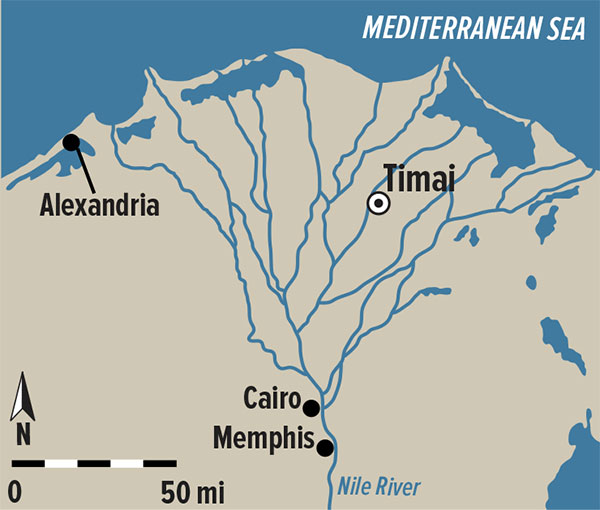
For thousands of years, at least since the fourth millennium B.C.E., people have been using mudbricks to build everything from houses to temples. Civilizations across Asia, Africa, Europe and the Americas have used them. Even today, many countries in the Middle East—Syria, Iraq, Yemen and Egypt—build multistory buildings with mudbricks. The modern word adobe traces its origin through Spanish, Arabic and back to the ancient Egyptian word for mudbrick, djebet. For the straw that Pharaoh denies to the Israelites, the Biblical text uses the word teben, but the word actually means, somewhat more broadly, “chaff.”
An examination of mudbrick production in ancient Egypt and ancient Israel helps us place the Biblical passage in context.1
Our site is in the village of Timai El Amdid in the Nile Delta, which still has many mudbrick structures, some of them collapsing. We hired a traditional mudbrick maker from the village to help us. He is a member of a dying profession. With his help during the summer of 2013, amidst the turmoil of what was then being called the Arab Spring, we were making mudbricks using ancient methods.
Before embarking on our mudbrick-manufacturing adventure, we analyzed the chemistry and particle morphology of ancient bricks from Tell Timai.2 Based on these results, we decided to recreate our mudbricks from the local soil that provided the closest match of materials. We wet the local soil and then added straw.
The primary ingredient for mudbricks, not surprisingly, is mud. Egyptians collected topsoil because it had the right composition of clay, silt and sand and formed the hardest and most durable brick.3 The alluvial deposits of the Nile in the delta were enriched by organic material, such as dung and chaff left in the fields after the harvest. This soil required less additional temper and less time to ferment.4
To create bricks capable of bearing the weight of large structures and surviving the elements, straw temper is added. The temper serves to absorb the stresses associated with drying, thereby reducing shrinkage and preventing the formation of fissures and cracks.
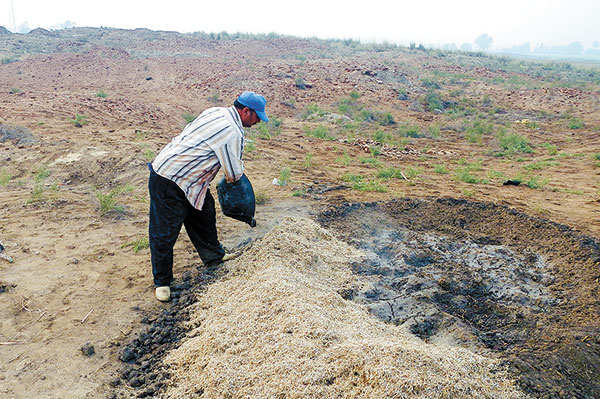
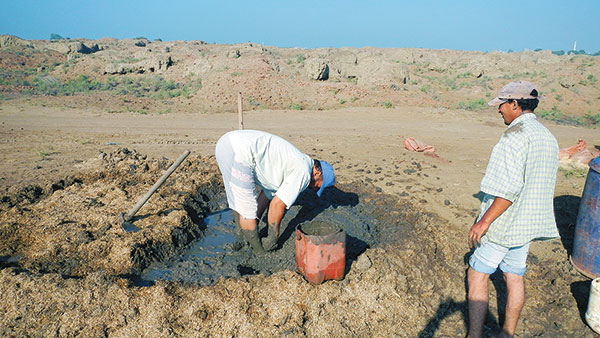
The proportion of straw to mud depends on the composition of the mud. Our brickmaker made the determination by feel during mixing, adjusting the formula as needed. Generally, a half pound of straw was required for each cubic foot of mud mixture. Obtaining the straw, as inferred from the pharaoh’s proclamation regarding the Israelites, was no easy task.
The straw from the Nile Delta produces an especially fine temper. The straw obtained after harvest has to be chopped into very small pieces (straw chaff) or acquired as a byproduct of threshing (grain chaff). This fine vegetal matter provided the optimal temper for production of mudbricks and mud-plaster.
We mixed the straw collected and prepared in this fashion with mud pulled from surrounding fields and canals and with water. The mixture was kneaded for four days until it fermented. Bare feet are still considered the best tool to knead the blend. Then the mixture was left to rest for a day or two and then kneaded again on the day the mudbricks were formed.
To form bricks from the mud, the mud mixture was poured into wooden molds. These molds were then carried to the drying floor (which had been layered with straw or sand so the bricks would not stick to the earth) where the mudbricks were deposited to dry. There they lay for a week, after which they were ready to be used or stacked for storage.
We used our new mudbricks to reconstruct some of the ancient mudbrick walls at Tell Timai. We added a red dye5 so our new mudbricks could be differentiated from the original bricks.
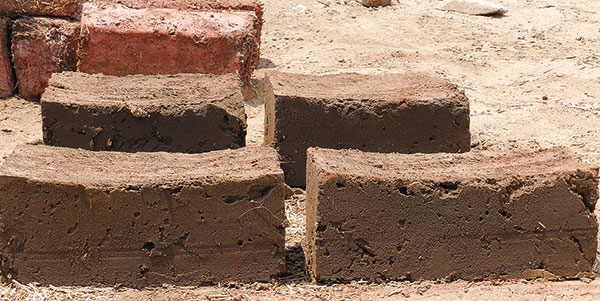
In two days we produced almost 2,000 bricks, the same number, incidentally, that ancient Egyptian records tell us was produced by Egyptian overseers. An Egyptian leather scroll in the Louvre, dated to year 5 of the reign of Ramesses II (1275 B.C.E.), relates that 40 stable masters (junior officers) were each responsible for a quota of 2,000 bricks produced by men under them. Another papyrus (Anastasi III) refers to people “making their quota of bricks daily.” Two other papyri (Anastasi IV and V) report that “there are no men to make bricks and no straw in the district,” stressing the importance of straw in brick manufacturing.6
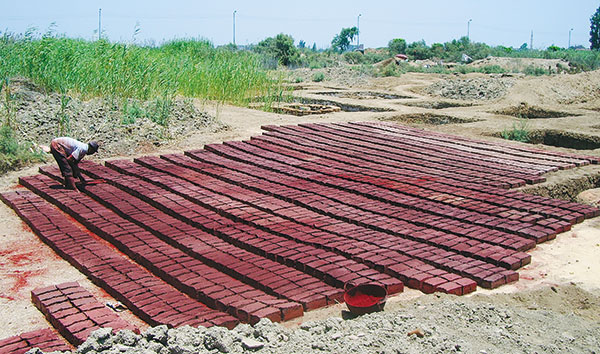
We also conducted an experiment: We made some bricks without straw. We used the same process to manufacture the mudbricks but left out the straw chaff. The bricks without straw were fragile and broke easily.
The best depictions of ancient brick making are in the justly famous tomb of Rekhmire, who was “governor of the town” of Thebes and vizier during the reigns of Tuthmosis III and Amenhotep II (15th century B.C.E.) during the 18th Egyptian dynasty. Rekhmire’s highly decorated tomb at Thebes contains scenes of daily life, as well as a hieroglyphic text detailing his duties as vizier.
The tomb paintings also depict an Egyptian overseer watching as captured Nubian and Semitic prisoners carry and then mix mud and water, using a mold to create bricks, which are then dried. The text speaks of “making bricks to build anew the workshops [of Amun] in Karnak.” Egyptologist Kenneth Kitchen has observed that these scenes offer a visual commentary on the description of Hebrew slaves in Exodus.7
Collecting the straw for the bricks is especially hard work. The straw is usually taken from the fields after the wheat has been harvested and crushed by the farmers. In ancient times, the Egyptians left the stems of the wheat in the fields. This minimized the labor needed for mudbrick production.
In Egypt (as well as the Levant), straw was available only after harvest time. This might create a serious hindrance in the construction process, as the bricks could be produced only during the dry season. Since construction with bricks was a year-round activity, chaff was collected and stored to ensure a continuous supply.
If Pharaoh did not supply the Israelites with straw, presumably from his storage units, then the search for the right chaff would have been almost impossible, which is perhaps the point of the story. The ancient reader would understand the difficulty of gathering chaff, a fact that is all but lost on the modern reader. Pharaoh in effect oppressed the Israelites by maintaining the quota of bricks without providing the materials necessary to produce them.
MLA Citation
Endnotes
For a general introduction to mudbrick in ancient Egypt, see Barry Kemp, “Soil (including mudbrick architecture),” in Paul T. Nicholson and Ian Shaw, eds., Ancient Egyptian Materials and Technology (Cambridge: Cambridge Univ. Press, 2000), pp. 78–103. See also Charles F. Nims, “Bricks Without Straw?” The Biblical Archaeologist 13 (1950), pp. 21–28. Coauthor Jay Silverstein was instrumental in developing our conservation project. We are also grateful to Dr. Fred Hiebert and the National Geographic Society for their support of our excavation and conservation.
The chemical analysis of the mudbrick was conducted under the direction of the late Dr. Adel Harfoosh of the Supreme Council of Antiquities, Egypt.
Maury E. Morgenstein and Carol A. Redmount, “Mudbrick Typology, Sources, and Sedimentological Composition: A Case Study from Tell El-Muqdam, Egyptian Delta,” Journal of the American Research Center in Egypt 35 (1998), pp. 129–146; Robert S. Homsher, “Mud Bricks and the Process of Construction in the Middle Bronze Age Southern Levant,” Bulletin of the American Schools of Oriental Research 368 (2012), pp. 1–27.
For the Louvre leather scroll, see Kenneth Kitchen, On the Reliability of the Old Testament (Cambridge: Eerdmans, 2003), pp. 247–248, 553. For the Anastasi papyri, see Ricardo A. Caminos, Late Egyptian Miscellanies (Oxford: Oxford Univ. Press, 1954), pp. 105–106, 188–189, 225.

